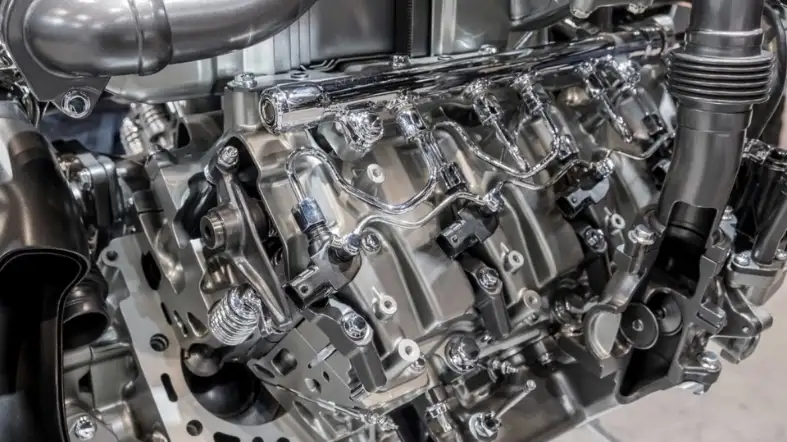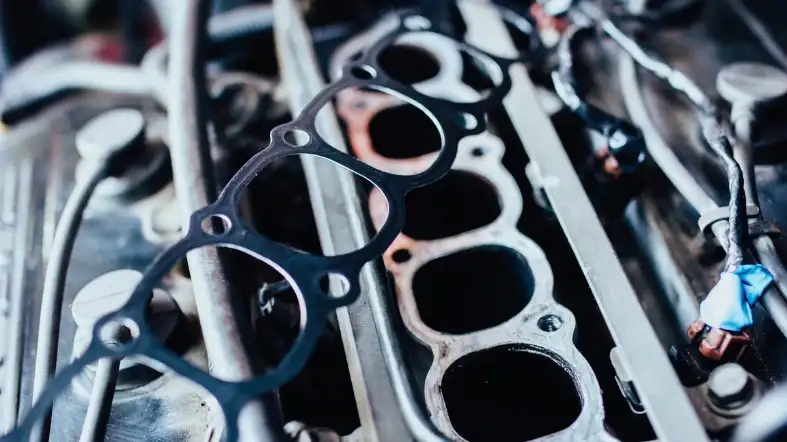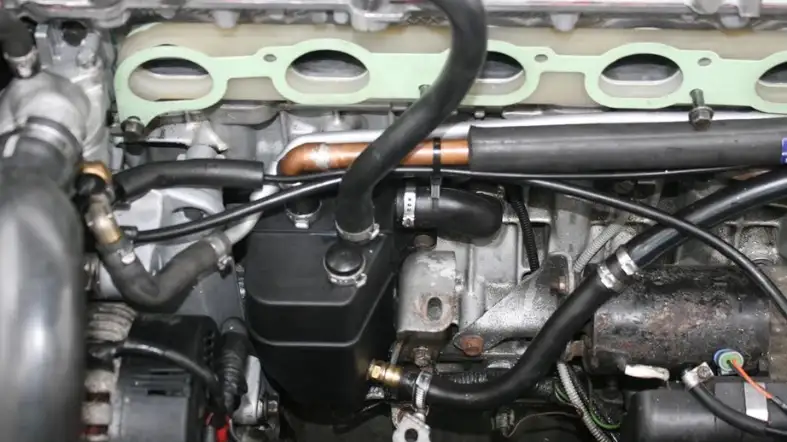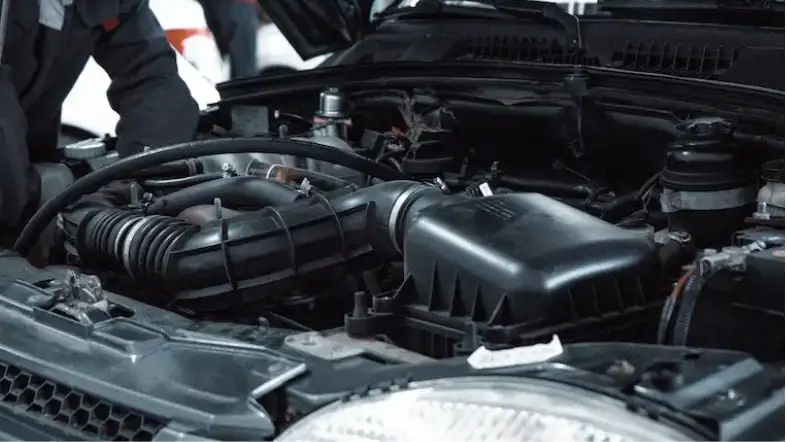Have you ever heard strange noises coming from your engine? One possible culprit for these sounds could be a bad intake manifold gasket.
This crucial component helps regulate the flow of air and fuel into your engine, and when it starts to fail, it can cause a variety of problems that are both annoying and potentially dangerous.
But how do you know if your intake manifold gasket is the problem?
In this blog, we’ll take a closer look at the signs and symptoms of a bad intake manifold gasket, so you can identify the issue and get it fixed before it causes more serious damage.
What does a bad intake manifold gasket sound like?
When an intake manifold gasket is bad, you may hear a few different sounds. One common sound is a hissing or sucking noise coming from the engine.

This is because air may be leaking out of the gasket, which can cause the engine to run poorly.
Another sound you might hear is a ticking or tapping noise.
This can happen if the gasket is allowing oil to leak out, which can cause parts of the engine to rub together and make noise.
What are the causes of a Bad Intake Manifold Gasket?
When this gasket fails, it can lead to various problems that affect your car’s performance and overall driving experience.
Here are some of the common causes of a bad intake manifold gasket:
1. Age and wear:
Over time, the intake manifold gasket is exposed to various stressors that can cause it to deteriorate and lose its sealing ability.
One of the primary factors is the constant expansion and contraction due to temperature changes.
The engine undergoes significant heating and cooling cycles during operation, and this repeated thermal stress can take a toll on the gasket material.
Additionally, engine vibrations, which are normal during operation, can contribute to the wear and tear of the gasket over the years.
The combination of these factors gradually weakens the gasket’s integrity, leading to potential failure.
2. Chemical damage:
The intake manifold gasket comes into contact with various fluids within the engine bay, such as engine oil and coolant.
Prolonged exposure to these chemicals can degrade the gasket material, making it more susceptible to leaks.
Engine oil, for example, contains additives and detergents that can break down the gasket’s composition.
Coolant, on the other hand, often contains ethylene glycol, which can have a corrosive effect on some gasket materials.
When the gasket’s material deteriorates due to chemical exposure, it becomes less effective at sealing the manifold, resulting in potential problems.
3. Poor installation:
During the assembly of an engine, proper installation of the intake manifold gasket is crucial.
If the gasket is not aligned correctly or if it is either over-tightened or under-tightened, it may not create a proper seal between the manifold and the engine block.
This can lead to leaks of air or coolant, affecting the engine’s performance and fuel efficiency.
Moreover, the gasket’s shape and design need to match the engine’s specifications to ensure a proper fit.
Any deviation from the correct installation procedure can compromise the gasket’s integrity and overall performance.
4. Overheating:
Engines generate a significant amount of heat during operation, and the cooling system, including the intake manifold gasket, plays a crucial role in maintaining optimal temperatures.
However, if the engine experiences prolonged periods of overheating, it can cause serious damage to the gasket.
High temperatures can cause the gasket material to degrade, lose its elasticity, and even melt in extreme cases.
When the gasket fails due to overheating, it can lead to coolant leaks, loss of compression, and potential damage to engine components.
5. Improper maintenance:
Regular maintenance of the engine is essential to ensure its longevity and proper functioning.
Neglecting the intake manifold gasket and the overall engine system can lead to problems.
If the gasket is not routinely inspected and cleaned, it can accumulate debris and become clogged.
A clogged gasket can lose its sealing ability, leading to issues like vacuum leaks, reduced engine performance, and rough idling.
Proper maintenance, including periodic inspection and cleaning of the intake manifold gasket, can help prevent such problems and extend its lifespan.
What are the symptoms of a Bad Intake Manifold Gasket?

Here are some common symptoms of a bad intake manifold gasket:
1. Engine Misfires:
A bad intake manifold gasket can cause air to leak into the engine’s combustion chamber, causing a lean fuel-to-air ratio.
This can cause the engine to misfire, resulting in rough idling, decreased power, and acceleration.
2. Coolant Leaks:
The intake manifold gasket also seals the coolant passages, and if it fails, coolant can leak from the engine.
You may notice a sweet smell coming from the engine or see puddles of coolant underneath your car.
3. Overheating Engine:
A coolant leak caused by a bad intake manifold gasket can also lead to engine overheating.
If the engine is not properly cooled, it can cause serious damage to the engine, leading to costly repairs.
4. Decreased Fuel Efficiency:
As air leaks into the engine, it can disrupt the fuel-to-air ratio, causing the engine to burn more fuel than necessary.
This can lead to decreased fuel efficiency, which can result in increased costs at the gas pump.
5. Poor Acceleration:
A bad intake manifold gasket can cause a decrease in engine power and acceleration.
This can make it harder for your car to reach high speeds or climb steep hills.
6. Rough Idling:
If the intake manifold gasket is damaged or failing, it can cause the engine to run roughly at idle.
You may notice shaking or vibrating in the steering wheel, dashboard, or even the entire car.
7. Check Engine Light:
A bad intake manifold gasket can trigger the check engine light to turn on.
If you see this warning light illuminated on your dashboard, it’s important to have your car checked by a professional mechanic as soon as possible.
How to Test for a Bad Intake Manifold Gasket?

A bad intake manifold gasket can cause a variety of problems, including decreased engine performance, poor fuel economy, and even engine damage.
Here are some steps you can take to test for a bad intake manifold gasket:
1. Look for coolant leaks:
A bad intake manifold gasket can cause coolant to leak from the engine.
Look for puddles of coolant under your vehicle, or check the coolant level in the radiator and overflow tank.
If the coolant level is low, it could be a sign of a leaky intake manifold gasket.
2. Check for oil leaks:
A bad intake manifold gasket can also cause oil to leak from the engine. Look for oil puddles under your vehicle, or check the oil level on the dipstick.
If the oil level is low or you see oil leaks, it could be a sign of a bad intake manifold gasket.
3. Look for vacuum leaks:
The intake manifold gasket helps to seal the engine’s intake system, which includes the throttle body and vacuum lines.
If the gasket is bad, it can cause a vacuum leak, which can lead to a rough idle, decreased engine performance, and other problems.
You can check for vacuum leaks by listening to hissing sounds or using a smoke machine to detect leaks.
4. Check for engine misfires:
A bad intake manifold gasket can also cause engine misfires.
This happens when air or fuel can enter the wrong cylinder due to the leaky gasket, which can cause the engine to run poorly or not start at all.
You can diagnose engine misfires using a diagnostic scanner or by checking the spark plugs for signs of damage.
5. Look for coolant in the oil:
If the intake manifold gasket is leaking coolant into the engine, it can cause coolant to mix with the oil.
This can lead to engine damage if not addressed promptly. You can check for coolant in the oil by checking the oil on the dipstick.
If the oil is milky or frothy, it could be a sign of a leaky gasket.
How to Fix a Bad Intake Manifold Gasket?

Fixing a bad intake manifold gasket is not that difficult, and you can do it yourself if you have the right tools and some basic mechanical knowledge. Here are the steps to follow:
1. Identify the problem:
The first step in fixing a bad intake manifold gasket is to identify the problem.
If you notice any of the symptoms mentioned above, such as decreased performance or overheating, you should check the intake manifold gasket for signs of wear or damage.
2. Gather the necessary tools and materials:
To fix a bad intake manifold gasket, you will need a set of wrenches, a socket set, a gasket scraper, a torque wrench, a new intake manifold gasket, and a can of gasket remover or brake cleaner.
3. Remove the intake manifold:
Before you can replace the gasket, you will need to remove the intake manifold.
To do this, you will need to disconnect any hoses or wiring connected to the manifold, and then unbolt it from the engine.
4. Clean the mating surfaces:
Once you have removed the intake manifold, you will need to clean the mating surfaces on both the manifold and the engine block.
Use a gasket scraper and gasket remover or brake cleaner to remove any old gasket material or debris.
5. Install the new gasket:
Once the surfaces are clean, you can install the new gasket. Make sure that it is properly aligned and seated on the engine block.
6. Reinstall the intake manifold:
With the new gasket in place, you can reattach the intake manifold to the engine. Use a torque wrench to tighten the bolts to the manufacturer’s specifications.
7. Reconnect hoses and wiring:
Once the manifold is securely attached to the engine, you can reconnect any hoses or wiring that you disconnected earlier.
8. Test the engine:
Start the engine and let it run for a few minutes to make sure that everything is working properly. Check for any leaks or abnormal noises
FAQs
Q. What Is An Intake Manifold Gasket, And What Does It Do?
A: An intake manifold gasket is a small but crucial component that sits between the engine block and the intake manifold.
Its job is to seal the connection between these two parts, ensuring that air and fuel are delivered to the engine at the right pressure and temperature.
Q. Why Does A Bad Intake Manifold Gasket Make A Hissing Or Sucking Sound?
A: When the intake manifold gasket fails, it can allow air to leak out of the engine’s intake system.
This results in a hissing or sucking sound as the air rushes out of the engine compartment.
If left unchecked, this can lead to a variety of other problems, including decreased engine performance and fuel economy.
Q. How Can I Tell If My Intake Manifold Gasket Is Bad?
A: If you suspect that your intake manifold gasket is bad, there are a few things you can do to confirm your suspicions.
First, try listening for any unusual sounds coming from the engine compartment while the engine is running.
You can also perform a visual inspection of the gasket itself to look for signs of wear or damage.
If you’re not sure what to look for, it’s always a good idea to consult a qualified mechanic or automotive technician.
Q. Can I Drive My Car With A Bad Intake Manifold Gasket?
A: While it may be possible to drive your car with a bad intake manifold gasket for a short period, it’s generally not recommended.
This is because a bad gasket can lead to a variety of other engine problems, including decreased performance, increased fuel consumption, and even engine damage.
If you suspect that your intake manifold gasket is bad, it’s best to have it inspected and replaced as soon as possible to avoid further damage to your engine
Conclusion
A bad intake manifold gasket can produce some distinctive sounds that can help you identify the issue.
Some common signs of a faulty intake manifold gasket include a hissing or whistling noise, a rough idle, and engine misfires.
You may also notice a decrease in engine performance or a strong smell of gasoline.
If you hear any of these sounds or notice any of these symptoms, it’s important to have your vehicle inspected by a qualified mechanic as soon as possible to prevent further damage to your engine.
